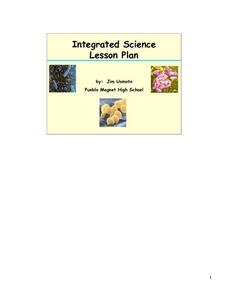Curated OER
Predators and Prey
In this predators and prey worksheet, students complete a graphic organizer to show the relationship between the number of predators and prey as the predators increase or decrease. Students explain the results, why they occur and they...
Curated OER
Dissection Webquest
In this dissection webquest, students research information on the internet about dissections. Students compare the 4 websites to note differences in the definitions, explanations, and graphics presented of the term dissection. Students...
Curated OER
The Making of an Organ
Students examine and research how cells make up our organs. They create a model of a tongue showing cells, tissues and the organ.
Curated OER
Imagining Your Science Fiction Short Story
Twelfth graders brainstorm ideas for their own science fiction story. Using worksheets, they sketch the plot and setting for their story. They create appropriate characters and develop their interactions among each other. They share...
Curated OER
Science Fiction
Students complete compare and contrast activities for two stories about racism and tolerance in the science fiction genre. In this literary analysis lesson, students read a Ray Bradbury short story and Walter Mosley poem, watch a related...
Curated OER
Scientific Method Unit: Bacteria
Young scholars discover how to apply the steps of the inquiry process through the study of bacteria. Working in groups of four, they cooperatively read an article about bacteria and complete a graphic organizer. Group members share with...
Curated OER
Things That Fly
Students locate images of two things that fly on the Internet and print them. They develop graphic organizers to compare and contrast the two images and exhibit the images along with the organizers in a classroom gallery.
Curated OER
Wild Weather Antonyms and Synonyms Worksheet
Have your language arts class expand their science-related vocabulary with this graphic organizer. They will take the 15 words listed and find an antonym and synonym for each.
Curated OER
Garden In a Glove
Students investigate the concept of seeds and how they can germinate. They obtain seeds and isolate them in a rubber glove before transplanting them into the ground. The lesson includes a graphic organizer for observations or information.
Curated OER
The Magic School bus Inside A Hurricane
Students investigate the concept of a hurricane by using the cartoon series "The Magic Schoolbus" to simulate the fantasy of traveling through a hurricane. The lesson uses a KWL graphic organizer in order to guide student inquiry and as...
Curated OER
Physical Agents for Microbial Control
For this biology worksheet, young scholars take part in an examination of the graphic organizer to determine the different types of environments and how they effect the survival of microbes.
Curated OER
VSEPR Theory: Valence Shell Electron Pair Repulsion Theory
In this atoms worksheet, students complete a graphic organizer by filling in the number of atoms, number of electron pairs, number of long pairs, bond angle, and molecular shape.
Curated OER
Properties
In this properties activity, students classify each of the properties given as either extensive or intensive and as either physical or chemical. This activity has 1 graphic organizer and 8 fill in the blank questions.
Curated OER
Ions and Subatomic Particles
In this ions learning exercise, students complete a graphic organizer by filling in the number of protons and electrons plus the charge of the given ion.
Curated OER
Ways to Recycle
In this recycling activity worksheet, students identify 3 ways that they could personally conserve or recycle. Students record their ideas in the graphic organizer.
Curated OER
Forming an Opinion with Organizational Elements - Cats, Yesterday and Today
In this age of information overload, it is often difficult for young people to know what they think about a topic. The graphic organizer, video, and activities included with this resource show middle schoolers how to use proven facts to...
Curated OER
Oil Well That Ends Well
Focusing on the effect of oil spills on the environment, learners conduct experiments to explore this issue. First, they create an ocean environment using materials provided. Then, they make a simulated crude oil substance from vegetable...
Curated OER
Fresh Foods from Farm to Table
Are you a good egg? Learners begin a farm-to-table lesson by acting out verbs in groups to demonstrate the egg production process, and then research the steps using online resources. Several excellent videos are linked through the...
Curated OER
Something's Fishy. . . Classes and Qualities of Fish and Seafood
If you are going to eat seafood, it helps to understand the different classifications. In this presentation, viewers learn to differentiate two types of finfish and the variations of edible shellfish. They also examine the...
EduGAINs
Go H2O! Investigating Residential Water Systems
Before your learners excuse themselves to get a drink at the water fountain, prompt them to think about where that water comes from. A middle school science lesson encourages groups to research their community's source of drinking water,...
US National Library of Medicine
Genetic Traits in Harry Potter
Explore human genetics through the world of Harry Potter. A thorough lesson develops the introductory concepts of genetics using characters of the popular book series. Learners study topics from DNA and chromosomes to Punnett Squares and...
Novelinks
The Martian Chronicles: Double-Entry Journals
Teach learners to reflect on their reading with a lesson about double-entry journals. As they read Ray Bradbury's The Martian Chronicles, class members note interesting passages from the text on the left side of their page, and jot down...
Curated OER
The Oceans, Waves, Tides & Currents
Your introductory lesson to oceanography can be outlined with this apropos presentation. It touches on the physical features of the ocean floor, waves, tides, and currents. One small issue is that some of the graphics are not of the...
Curated OER
Newton's Laws
In this motion worksheet, young scholars read about the 3 laws of motion and then complete a graphic organizer describing the laws and giving an example for each one.

























